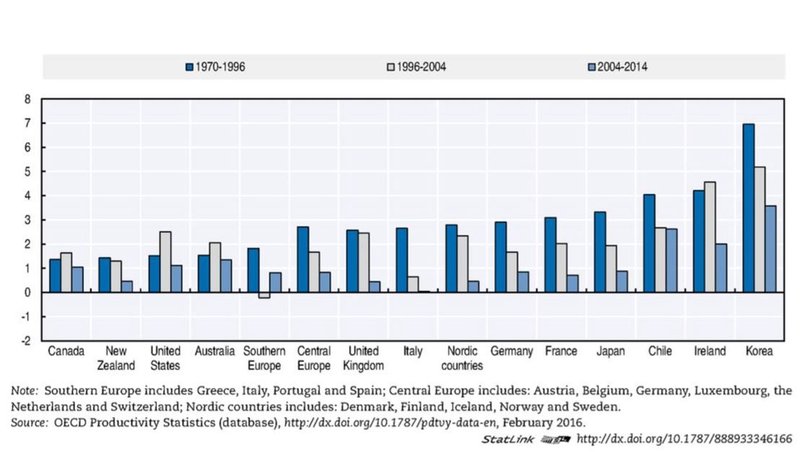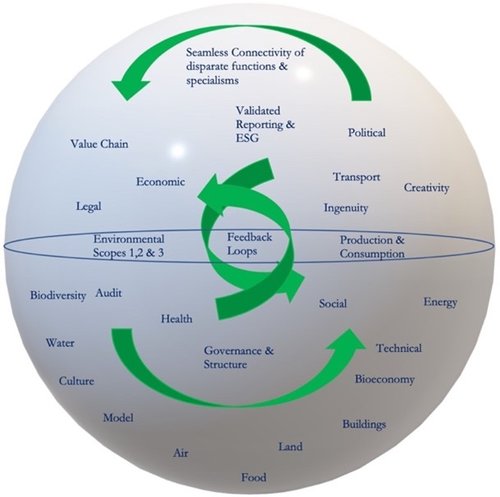Sustainability, ESG, And The Productivity Paradox
Monday, 15 November 2021By Christopher Gleadle
Introduction

Sustainability and ESG have a number of contradictory messages. Firstly, the culture of sustainability and ESG has developed groupthink that is process-focused instead of outcome-focused. As a result, the narrative gets stuck on diagnosing problems rather than offering scalable practical solutions. This means it is evermore unlikely that organisations and economies can be decarbonised fast enough to meet the stated IPCC goals. In contrast, the culture of sustainability and ESG is agreed that there is an urgent need for rapid decarbonisation.
Since science provides clear evidence that emissions continue to rapidly rise, and services of the biosphere rapidly declines, and that both the above statements are true, we have a toxic paradox.
In contrast, I am of the firm belief, achieving an authentic ‘net-zero’ global economy is not only practical and economically feasible, but it can also be achieved within a time scale ahead of current stated aims. However, to achieve this ambition something must change.
Innovation
Innovation comes in many forms. To achieve an authentic ‘net-zero’ environment requires acting in a carbon-negative manner at the crossroads of what we have already, and how we use it. This will buy the time for tomorrow’s new tech. However, this route needs a radical shift in decision making behaviour that involves better, more complete decisions that are made in the right order and consider competing decisions in other interdependent areas. Decisions born from outcome focussed not process focused deliberation.
Such radical shifts in decision behaviour will result in functional and structural harmonisation. This will create a low-waste, zero-waste, carbon-negative economy that raises the bar on productivity, since a function of sustainably viable[1] operations (private, public or third sector) is to enhance performance (from the effects) of multiple interacting ecosystems - investment, organisational, environmental, governance, and social.
Productivity Is A Gauge Of Sustainability Quality
Productivity is most often hampered by disengaged, siloed, fragmented teams that are programmed, budgeted, and rewarded to do what is right for themselves regardless of the whole.[2]
Teams, while they may be diverse and experienced, are distanced from each other by design and tackle various issues in wholly different ways. This leaves multiple engagements disjointed. As a result, work is sub-optimal, and riddled with unseen negative impacts between functions since broken systems take no account of feedback loops in either decision making or operation. Consequently, such a traditional approach to operations is simply not viable; not sustainable.
As the OECD have shown in their Compendium of Productivity Indicators 2016/8, productivity growth not only remains below pre-crisis levels, but declines had become evident even before the financial crisis. Seen against the backdrop of rising technological advance, and the circular economy, there is clearly a paradox.

The thinking and actions that have created the paradox are never going to be effective in providing the cure: perception trumps substance.
Further concern is the paradox that can be seen in the increase of income and wealth inequalities. Surely, it is natural to see this relationship as causal, as inequalities create unequal opportunities. They trap individuals in lower skilled and lower productivity activities, with lower earnings, higher job insecurity and poor working conditions.
Expand The Decision Space
A decision space is defined by the range of options at the decision maker’s disposal. For each option there is a distribution of possible consequences. Each distribution is a function of the uncertainty of elements in the decision situation and uncertainty regarding executing the course of actions defined in the decision option.
Yet, our personal decision spaces are tethered to our education, culture, belief systems, training, as well as social, political, and corporate pressures and connections.
Consequently, is it any wonder why we have advanced so much technically, yet have just as many, if not more, problems in the world, of even greater magnitude than 100 years ago?
Science shows:
- emissions are still rising
- services of the biosphere are shrinking
- productivity is on the decline
- society is fractured

Perhaps we need urgently to look at the decisions we are making, and how they are made?
In order to be innovative and see beyond the current situation we need to expand the decision space. This will help unlock resource-efficient productivity growth as goals become shared, and shared goals tackle inclusion gaps via feedback loops. For example, we have already seen productivity deceleration despite technological improvement. Technological advance requires parallel innovation in organisational structures and business models. The paradox suggests such innovation has not taken place.
Productivity growth will be enabled through access to better knowledge management across systems through the expanded decision space[3].
Expanded decision space offers speedier, better-informed decisions, with more desirable outcomes since unintended consequences are revealed as systems and knowledge become linked from shared intent in meeting shared goals. Resource efficient productivity gains are generated through improved sight of value destruction as well as the delivery of disruptive changes in the production and delivery processes as part of the value creation system.
Long-term value is defined through the sharing of productivity gains and goals from the exploitation and creation of new and emerging technologies, investment in human capital and fostering eco-innovation.
Through the expansion of decision space, we can visualise feedback loops that tackle resource efficient growth, inclusion gaps, and fragmented operational and governance functions.
“Unless we adopt a systems approach, unless we employ systems thinking, we will fail to understand the world we are living in. This is a world made up of complex systems, systems of systems interacting with each other, and changing each other by that interaction and the links between them.” OECD, 2017
The Sphere Economy

Sometimes it is not about things but the relationship between things
To achieve an authentic, climate-neutral economy requires not only the participation of industry, but also a transformation of all value chains. And, while the two-dimensional ‘circular economy’ offers great potential, optimisation is held back since ‘CE’ has waste streams and misbehaviour between functions over time from missed feedback loops. As described above, such behaviour underpins the persistence of suboptimal productivity and outcomes.
The Sphere Economy tackles multiple issues simultaneously. As a result, it raises the bar on productivity that in turn accelerates action toward an equitable and authentic net-zero world. A spherical economy supports decision making in three-dimensions over time. As a result, decision makers will now understand the consequences of (and between competitive) decisions to drive down emissions and waste today. This will help modernise economies as well as draw benefit from the opportunities of an efficient, comparable, and authentic low-carbon, low-waste / zero- waste economy.
Conclusion
Outcomes of current hierarchical structures expose the lack of diverse practical critical thinking in decision making. We merely continue what we have got. As a result, the moral hazard of IPCC target failure becomes ever starker as each year goes by where we do not deliver precipitous declines in emissions and waste.
“Insanity is doing the same thing over and over again expecting different results” , often erroneously attributed to Albert Einstein.
Do not focus on one number (5 Essential Steps). To use Greenhouse Gas Emissions as a sole expression of emission impact limits the decision space to optimise climate projects. For example, to measure environmental return on investment in a manner like the stringent standards of financial return would force open the decision space and measure actions collectively rather than in isolation. As a result, the efficiency and productivity of resource use and feedback will be maximised. Accordingly, decision makers would become accustomed not to look at one number but understand against the outcome – to reduce the warming of the biosphere - measurements such as Global Warming Potential (GWP) allows for equivalence across systems. Accordingly, GWP presents itself as a superior gauge to deliver comparability and support envirosocial return on investments for sustainably viable, superior, risk adjusted returns.
Simply put, using better what we have, thinking more completely in an integrated systems manner, and making more informed decisions in the right order that consider feedback loops, will lead us all to over perform against the targets set.
“Complexity is a core feature of most policy issues today and in this context traditional analytical tools and problem-solving methods no longer work.” OECD 2020
1 The Five Essential Steps to Sustainable Viability, C Gleadle, 2018
2 Sustainability and the importance of the CFO, UNEP Climate Action Plan, 2011
3 The concept of decision space holds appeal as an approach to disaggregating the elements that may influence decision-making in decentralized systems. Roman et al, 2017